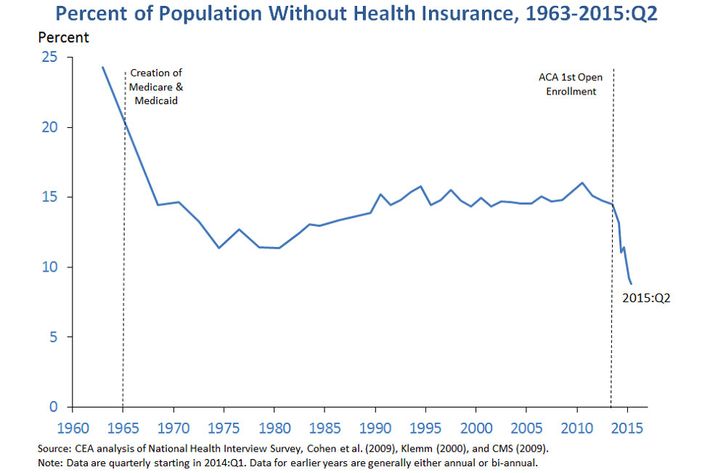
Two years ago this time, conservatives were giddily predicting that Obamacare would collapse, “a failure of the administrative state on a level unimagined even by its staunchest critics,” a failure “so catastrophic that vulnerable Democratic Senators and even President Obama could come to view repeal as the face-saving option.” Over time, they have retreated slowly, never conceding that Obamacare is working as designed, and trying to make use of whatever bits of gloomy news can be found. Ross Douthat’s Sunday column, as it so often does, offers the least unreasonable iteration of the deranged state of conservative thinking on Obamacare. While no longer collapsing spectacularly, Obamacare is now sadly limping along in disappointing fashion, remaining just healthy enough not to expire.
To bolster this case, Douthat makes four points against the law. Here they are in order. Individually, and collectively, they present a wildly misleading picture of a law that continues to work very well. Douthat:
First, after the initial surge, Obamacare’s enrollment numbers have mostly disappointed. Not in a catastrophic way — the law has knocked down the U.S. uninsured rate to about 11-12 percent, compared to a pre-Great Recession level of 14-15 percent. But depending on how you cut the numbers, it looks like the Obamacare exchanges will fall at least four million enrollees short of the target for 2016.
First, note that Douthat compares the uninsured rate to its level before the recession — which assumes it would have returned to that level on its own. This is unlikely, since the uninsured rate has been rising for decades. If you want a complete, non-cherry-picked measure of the change in the uninsured rate, here it is:

Anybody who actually cares about expanding access to insurance — as opposed to wanting to troll people who do — would consider that a historic success.
What about the exchanges? Yes, they have fallen somewhat below projections, in part because employers have dumped fewer workers onto the exchanges. Sign-upsdrove hospital stocks higher this week.
Douthat continues:
Moreover, the people who are enrolling are sicker and more heavily-subsidized than either the White House or the participating insurers had hoped; the healthy uninsured are often choosing to pay the fine (sorry, Chief Justice Roberts, I mean tax) and go without coverage. Which means the initially lower-than-expected premiums charged on the exchanges are headed upward, and major insurers may end up following United Healthcare for the exits if the numbers don’t improve.
When Obamacare started, health-care premiums came in far, far lower than expected. As Jonathan Cohn explains, they have floated back up to correct for the initial error, but still remain lower than forecast. And as Cohn also explains, United Healthcare is just one relatively small player in the exchange markets. Provider interest overall has risen, not fallen, as Cohn point out: “Meanwhile, the average number of companies selling insurance on the marketplaces in each state rose from eight in 2014 to nine this year, and will be 10 next year, according to the Department of Health and Human Services.”
Douthat:
Meanwhile, the excited liberal claim that Obamacare has bent the overall health care cost curve downward looks, well, premature. After five years of slower-than-expected growth, cost growth spiked higher in 2014, a new Health Affairs paper indicates — driven, in part, by the Affordable Care Act’s coverage expansion.
This is just horribly misleading. Bending the cost curve was always designed to mean slowing the long-term growth of health-care costs. Designers of Obamacare expected and intended for overall health-care spending to spike in the first few years benefits became available — because millions of people who were denied medical care would now be able to get it! Obamacare is trying to restrain the price of medical care, not spend less by denying it to people who are too poor or sick to afford it on their own.
The difference between price and total spending level is essential to the entire theory of bending the cost curve. It is jaw-dropping to watch conservatives treat them like they’re the same. Douthat and other leading intellectuals of the right, including Yuval Levin, have all cited this Health Affairs paper as evidence that Obamacare is failing to bend the curve. The headline of the paper reads, “National Health Spending in 2014: Faster Growth Driven by Coverage Expansion and Prescription Drug Spending.” The point about prescription drug costs is a bit of a sidelight — drug-makers go through cycles, and currently a handful of very expensive new drugs have boosted prescription spending. But “faster growth driven by coverage expansion” is not Obamacare failing to succeed. It’s Obamacare succeeding! If we had faster growth driven by higher prices, it would be Obamacare failing to bend the curve. That is not happening:
More Douthat:
The bill delays not only Obamacare’s medical-device tax, much hated by industry lobbyists, but also the so-called “Cadillac Tax” on high-cost insurance plans, which was crucial to the health care law’s ambitions to be a deficit-reducing, cost-bending success. When Obamacare first passed, many conservatives expressed skepticism that its “taxes to be implemented later” would actually be implemented; now we have evidence that they were right.
This is a real piece of bad news for Obamacare. The law created several mechanisms both to finance the cost of coverage and to bend the curve. The Cadillac Tax does both these things. The tax is really a withdrawal of the tax break for employer-provided insurance, applying only to the most expensive category of plans. The rationale for taking away the tax break for expensive insurance is to encourage employers to shop for cheaper plans for their workforce, and spend the money they would have used on insurance on wages, which would also be taxed as income, raising revenue.
Economists love this idea. Unfortunately, politicians hate it. The worst thing that’s happened to Obamacare is that Democrats have revolted against the Cadillac Tax. President Obama had to agree to delay the tax’s implementation for two years as part of the recent budget deal, in return for lots of good liberal policy (like tax breaks for green energy and low-income families). The Cadillac Tax would be in decent shape if Obama could just use his veto to keep it in place two years from now. The trouble is that Hillary Clinton, pressured by unions, has also come out against the Cadillac Tax. So now you have pro-union Democrats and anti-tax Republicans forming a coalition that looks like it can prevail starting in 2017, regardless of which party wins the election.
So, yes. Bad news for Obamacare, which looks like it has lost one of its many cost-control elements. But as bad as this news is for Obamacare, it’s absolutely catastrophic for Obamacare replacement. Every Republican plan to replace Obamacare relies on the same financing mechanism: limiting or repealing the tax break for employer-sponsored insurance. The Cadillac Tax is a smaller, more painless version of this same policy. If both parties can’t abide a partial rollback of the tax break for the most expensive health plans, they’re never, ever going to go along with eliminating the entire tax break for all health plans. The conservatives cackling over the demise of the Cadillac Tax are delusional — it’s as if they’re watching the backlash against the Iraq War in 2008 with fingers tented, anticipating that this will encourage war-weary Americans to support a land invasion of Russia. The bipartisan support for maintaining the tax break for employer insurance will hurt Obamacare, but it can survive. The Republican plans to replace it would all be wiped out.
The Cadillac Tax debacle illustrates a crucial underlying reality of the politics of health-care reform: Change is incredibly difficult. That is why the United States staggered along for decades with a system that simultaneously spent far more per citizen than any other system in the world and cruelly denied treatment to millions. The compromises in the law are a function of this reality. Obamacare’s drafters could not draw up a blue-sky plan as though they were free to design the system anew. They had to work around an entrenched reality, making the system more humane and efficient without unduly burdening those who feared change. That they managed to pass and implement such a reform in the face of hysterical opposition is a historic triumph, one with which the opposition, five-and-a-half years later, has not come to grips.






























